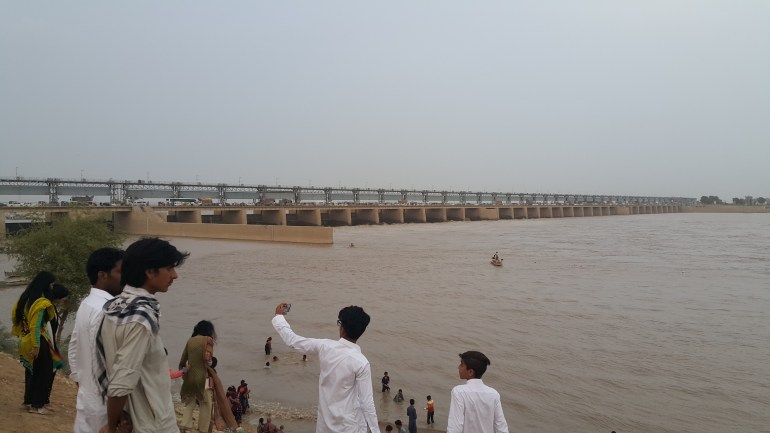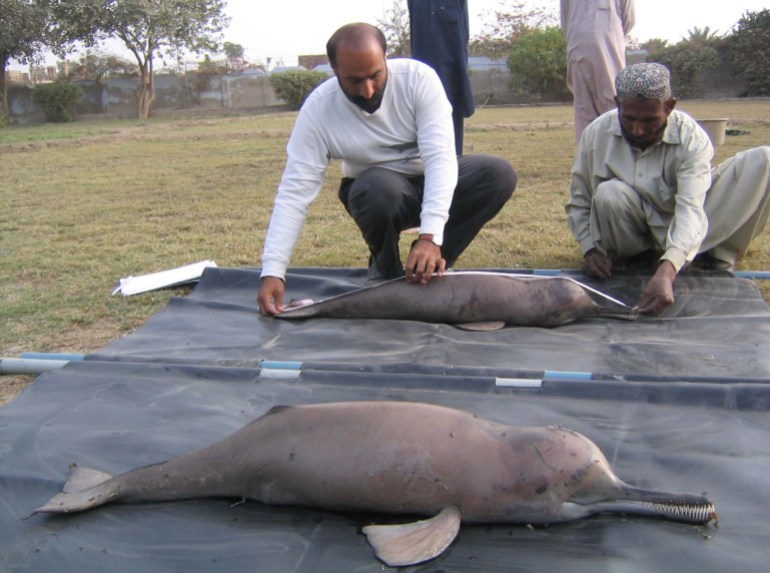Gliding through the waters of the Indus River, Pakistan’s river dolphins – known locally as “bulhan” – can be glimpsed as they rise up to gulp air before submerging once again into the murky waters.
It was a rare sighting in 2004 that spurred the then-14-year-old Zulfikar Ali Bhutto to become a climate activist. Now 33, the acclaimed artist and grandson of his namesake, the former president of Pakistan, said that until that moment, he had only ever heard about the fabled dolphins from stories told by older family members. “I knew about them, and people knew that they existed in the river. To me, they were almost like unicorns,” he told Al Jazeera.
The dolphins, whose numbers had dwindled severely since the early 1900s, started to make a slow comeback in the 1970s when the hunting of dolphins for their meat and blubber was outlawed. Now, more and more are being spotted in the river again.
What are the Indus River dolphins?
Unlike unicorns, the Indus River dolphins are very real. They are, however, at risk of extinction, and despite more of their number being identified in recent years, they remain on the International Union for Conservation of Nature Red List of endangered species.
Part of the cetacean family, a group of mammals that also includes whales and porpoises, these dolphins have distinct, elongated noses like blunt swords, which they use to find food along the bottom of the river. They have minuscule eyes – “as big as pinpricks to protect them from river silt that builds up in their freshwater habitats”, Bhutto explained. In fact, the dolphins are functionally blind – unable to see objects but able to detect shifts in light.

The Indus River dolphin (Platanista gangetica minor) and its cousin, the Ganges river dolphin – locally known as “susu” (Platanista gangetica gangetica) – are two river dolphin subspecies that are today the only surviving members of a once primitive and widespread group of archaic cetaceans that swam in the ancient Tethys Sea 50 million years ago. The Tethys Sea once covered what is now India, Indonesia and the Indian Ocean.
As the lands shifted and sea levels dropped, the freshwater-only Indus River dolphins were left behind in inland rivers in what is now Pakistan.
Back in the late 19th century, dolphins swam in the lower parts of the Indus in Pakistan and in the Beas River, a tributary of the Indus River in Punjab, India.
In 1878 and 1879, a survey carried out by the British zoologist John Anderson tallied about 10,000 dolphins across what was then British India. In 2001, a survey by the Wildlife Department of Pakistan’s Sindh province found 617 dolphins remaining in the Indus River. This number rose to just under 1,000 in 2004. Today, there are 2,100 – an improvement, but not enough.
The survival of these dolphins is crucial to the local ecostructure. They are considered an “indicator” species, acting as an indicator of the health of the rivers in which they live. “They are the canaries in the coal mine of freshwater,” Bhutto said. “If they are breeding and reproducing, it means they are doing well. If there is a drop, then it means something is wrong in the river’s ecosystem.”
What caused the dolphin population to dwindle?
Bhutto cited the work of Gill Braulik, a leader in the conservation of marine mammals who is based at St Andrews University in Scotland. In 2012, she proved that a series of dams and barrages (low-level dams) built by the British in the mid-20th century had led to the river dolphins’ decline.
Barrages, in particular, were built to divert water into canals to irrigate farmland. This caused some areas of the river to become too shallow for the dolphins, which have also frequently been trapped by gates built into the barrages.
The barrages have segmented the river and artificially isolated the dolphin population. When a barrage opens its gate, a dolphin may be swept downstream and is then unable to swim back upstream as it once could because of strong currents created by the barrages. Being trapped in the lower parts of the river is problematic because water extraction to the canals means the river dries up for several months each year.
The barrages “systematically annihilated the dolphin populations in the tributaries”, Bhutto said.
The Sukkar Barrage, built in Sindh, Bhutto’s home province, to control flooding and provide irrigation, was the first to open in 1932. Today, it feeds into the largest irrigation system in the world, providing irrigation to more than 7.63 million acres (nearly 31sq km) of land.
Five more would follow from 1946 to 1971: the Guddu Barrage, the Kotri (also known as the Ghulam Muhammad) Barrage, the Taunsa Barrage, the Chashma Barrage and the Jinnah Barrage.

The river dolphins, which once had free reign over the waterways, had been able to swim all 3,180km (1,976 miles) of the Indus, from the foothills of the Himalayas and Karakoram mountains to its delta in Sindh, where its waters empty into the Arabian Sea, and all of its tributaries. But these new structures meant they were now contained within the six smaller enclaves that existed between these barrages.
While swimming along the canals, which were built following the natural pathways of the river’s tributaries, many became trapped, stuck in shallow canals or, worse, caught in fishing nets.
“They need to come up for air every two to three minutes. If they get trapped in a net, then they can drown within five minutes,” Bhutto explained. “They are extremely fragile creatures.”
“We don’t know how much of the population declined in those days [the mid-1900s] as they weren’t being tracked, but it declined, becoming almost extinct in the tributaries, so there was only a population left in the mainstream of the river.”
By 1960, the government of Pakistan had concluded that the Indus River dolphin had become extinct, but a group of fisherfolk spotted a couple, and soon, with the help of an Italian researcher, a population of 150 had been discovered by 1969.
In 1974, the Sindh Wildlife Department was established. It launched the campaign that would make hunting dolphins illegal and categorised them as a protected species. “On last inspection in 2021, the dolphins were estimated to be around 2,100,” Bhutto said.
Has the danger passed?
While the numbers are up, conservationists are not able to consider their jobs done, Bhutto said. They need to continually monitor the mammals, which give them a much larger picture.
“If dolphins are happy and thriving, it means the water quality is fairly good. It means there are resources in the river, like fish, clams and shrimp the dolphins eat. But if there is a drop in the population of dolphins, then something is wrong. You know something is not right with the river.”
The river’s waters irrigate Pakistan and are vital to sustaining life in the region. Without their flow, Bhutto explained, crops will fail. “If the Indus River Basin collapses, 80 percent of this country will face starvation to the point of death,” Bhutto warned in a post on X in 2023.
“Just imagine, at one time the Sindh delta was full of water, and I think that’s now been reduced by 99 percent in the past 100 years,” he said. “It sits dry for eight months of the year with the river not being able to reach the sea. If there’s no water, then there’s no life.
“Right now, after Hyderabad, the river stops flowing, so that’s the last 300km [200 miles] of the river. Sadly, only in flood season does the sea actually get river water.”

How has climate change affected the dolphin population?
Research shows climate change can cause dramatic shifts in ecosystems and can negatively impact river dolphins.
Higher temperatures, melting glaciers and increased rainfall can all impact river levels and the dolphins’ environment. Dolphins have adapted to temperature rises over the past century. What they cannot do, however, is adapt their geographical range for survival and flourish while remaining restricted to a 190km (120-mile) stretch of the Indus River (the distance between barrages).
“Climate change is not the main culprit for their decline, but it could affect their existence in the future,” Bhutto said.
Pakistan is ranked the fifth most vulnerable country to climate change on the Global Climate Risk Index with its temperatures forecast to rise between 4 percent and 6 percent by 2050.
“If there is a drought – the reverse of the floods of 2022 – 70 percent of the dolphins in the 100km [60-mile] area from Sukkar to the Guddu Barrage will be affected,” Bhutto said. While flooding brings more water to the river, dolphins can become trapped on dry land when the floodwaters recede.
September last year was one of the hottest months on record globally. Reports differ on numbers, but it was during that month that somewhere between 125 and 200 river dolphins died in Brazil’s Lake Tefe from unusually high water temperatures of as much as 40 degrees Celsius (104 degrees Fahrenheit).
“And remember, Brazil has the Amazon Basin. It’s the biggest basin in the world. It has thousands of streams, so there are so many places where the dolphins can go [to escape the hot waters]. In Pakistan, it’s just one river system,” says Bhutto.

Could the dolphins still face extinction?
If river temperatures do rise significantly in Pakistan, “our dolphins could face the same fate,” Bhutto warned.
Other species facing similar dangers have become extinct. For instance, these dolphins’ cousins in China, known as the “baiji”, once swam in the Yangtze River but were declared extinct in 2007 because of an increase in the number of boats operating on the river as well as noise and water pollution.
The gharial, a type of crocodile, has already disappeared from Pakistan’s biodiverse landscape, largely because of barrages and hunters. Apart from one sighting in 2023, the last time one of these creatures was seen was in 1985.
“Climate change may not have been the reason for their [the crocodiles’] decline at the turn of the century or even during the Green Revolution [a period from 1950 to 1984 when crop yields increased due to technological advancements in farming], but sadly, it is a concern,” Bhutto said.
How can their survival be ensured?
To save the dolphins and other wildlife, all building on the river must cease, Bhutto said.
“We don’t need more dams; they will just exacerbate and quicken the process of climate change.”
Dams release greenhouse gases from a build-up of methane gas produced by bodies of still water. They can also deprive ecosystems of nutrients they need by trapping sediment. Riverbeds where fish spawn along with food and habitat features can also become trapped behind dams.
“There are plans to build more as the government sees them as a quick fix to Pakistan’s growing energy needs, but this will certainly threaten their [the dolphins’] existence,” Bhutto said.
He argued that Pakistan’s urban population is “blissfully unaware” of the danger and is taught that without damns, water is a wasted resource. What they don’t get told is that it’s a living source of energy that needs to be saved.
“The river will show its anger. It will show its rage. Be that in a flood, be that in a drought,” he said.
The millennia-old Indus River has always served local communities. Bhutto believes it is vitally important to listen to the concerns and advice of the rural populations and to the fishing communities strongly connected to the river’s ebbs and flows.
“What I don’t want is for one day the bulhan to only ever be heard of through the ancient fables about Sufi saints like Khawaja Khizr as they float passed his shrine and that of others that sit on the river banks,” Bhutto said.







